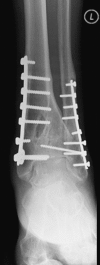Long-Term Wound Palliation to Manage Exposed Hardware in the Setting of Peripheral Arterial Disease
- PMID: 30881824
- PMCID: PMC6416131
- DOI: 10.1097/GOX.0000000000002058
Long-Term Wound Palliation to Manage Exposed Hardware in the Setting of Peripheral Arterial Disease
Abstract
Exposed orthopedic hardware in the lower extremity complicated by peripheral arterial disease typically demands multiple operative procedures by several disciplines to maintain skeletal integrity and achieve complete wound healing. For ambulatory patients that are either not candidates for lower extremity revascularization or prefer not to pursue surgical attempts at limb preservation, wound palliation is a potential management strategy. We discuss a patient with a history of severe peripheral arterial disease and a left pilon fracture previously treated with open reduction and internal fixation. He presented with a 2-month history of open wounds and exposed hardware over his left tibia. Though he initially underwent surgical revascularization to improve circulation to his lower extremity, the arterial bypass occluded within 6 months of the operation. At that point, the patient decided to forego any additional surgical intervention, including hardware removal, in favor of local wound care and expectant management. Remarkably, the wound remained stable in size over the next 14 years, he remained ambulatory, and never developed a deep wound infection. Though palliative wound care alone is understandably not the recommended first-line therapy for managing nonhealing wounds, it may be a safe and potentially durable alternative to major lower extremity amputation when revascularization and soft-tissue coverage cannot be achieved.
Figures


Similar articles
-
A staged protocol for soft tissue management in the treatment of complex pilon fractures.J Orthop Trauma. 2004 Sep;18(8 Suppl):S32-8. doi: 10.1097/00005131-200409001-00005. J Orthop Trauma. 2004. PMID: 15472563
-
A staged protocol for soft tissue management in the treatment of complex pilon fractures.J Orthop Trauma. 1999 Feb;13(2):78-84. doi: 10.1097/00005131-199902000-00002. J Orthop Trauma. 1999. PMID: 10052780
-
A conservative approach to select patients with ischemic wounds is safe and effective in the setting of deferred revascularization.J Vasc Surg. 2020 Apr;71(4):1286-1295. doi: 10.1016/j.jvs.2019.06.199. Epub 2020 Feb 19. J Vasc Surg. 2020. PMID: 32085957
-
Patient recovery after infrainguinal bypass grafting for limb salvage.J Vasc Surg. 1998 Feb;27(2):256-63; discussion 264-6. doi: 10.1016/s0741-5214(98)70356-8. J Vasc Surg. 1998. PMID: 9510280
-
Operative treatment of early infection after internal fixation of limb fractures (exclusive of severe open fractures).Orthop Traumatol Surg Res. 2017 Feb;103(1S):S67-S73. doi: 10.1016/j.otsr.2016.06.019. Epub 2017 Jan 2. Orthop Traumatol Surg Res. 2017. PMID: 28057476 Review.
References
-
- Viol A, Pradka SP, Baumeister SP, et al. Soft-tissue defects and exposed hardware: a review of indications for soft-tissue reconstruction and hardware preservation. Plast Reconstr Surg. 2009;123:1256–1263. - PubMed
-
- Nahabedian MY, Orlando JC, Delanois RE, et al. Salvage procedures for complex soft tissue defects of the knee. Clin Orthop Relat Res. 1998;356:119–124. - PubMed
-
- Wong MS. Consult for exposed hardware. Plast Reconstr Surg. 2005;116:1574–1575. - PubMed
-
- Pu LL. Soft-tissue reconstruction of an open tibial wound in the distal third of the leg: a new treatment algorithm. Ann Plast Surg. 2007;58:78–83. - PubMed
Publication types
LinkOut - more resources
Full Text Sources
